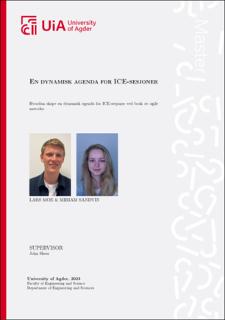| dc.description.abstract | An increasing number of companies in the construction industry are adopting the VDC fram-
ework. VDC is a framework of existing methods, theories, and practices that support the use
of multi-disciplinary, virtual models of product, and process to achieve the project’s business
objectives. Effective collaboration among project stakeholders is a fundamental part of the
VDC framework. The framework utilizes the ICE methodology to enhance collaboration.
The ICE methodology is a systematic approach to collaboratively identify, and solve project
challenges. The starting point for achieving a successful ICE session is establishing an agen-
da. Therefore, qualitative research through interviews, observations, and literature search
has been conducted, in order to establish how the project team can create a dynamic agenda
for ICE sessions. To achieve this, the master thesis will examine how companies can derive
inspiration from various Agile methodologies in order to create a dynamic agenda. Like the
VDC framework, Agile methods share the principle of involving multiple stakeholders in
the development process, but Agile methods differentiate themselves from VDC through a
greater focus on flexibility and adaptation.
This thesis follows a construction project in Oslo that has recently initiated its first VDC
pilot project. The research question was developed through initial observations of the project.
Upon initial observations, it became apparent that the project management team exclusively
determined the agenda for the ICE sessions, and the agenda itself was planned well in advance
of the actual session. The study’s main findings suggest that the project management team
should facilitate increased collaboration when defining the agenda of the session. It is also
important to ensure good communication, in order to improve the group’s preparatory work
and ensure that the group has a sufficient understanding of the VDC framework. The use
of a Hybrid method between Kanban and Scrum has been suggested as a possible solution
to handling the challenges discovered in this thesis. The Scrumban board visualizes project
tasks and enables the team members to categorize, prioritize, and distribute the assignments.
The-ICE agenda becomes its own section on the Scrumban board by creating a sprint backlog
that is reset after each ICE session, drawing elements from the Scrum methodology. | |
